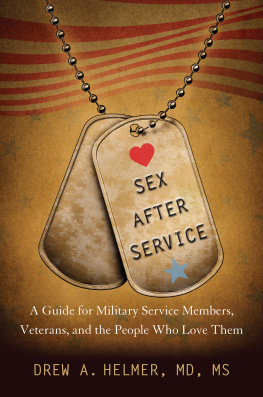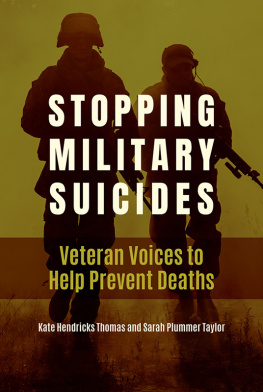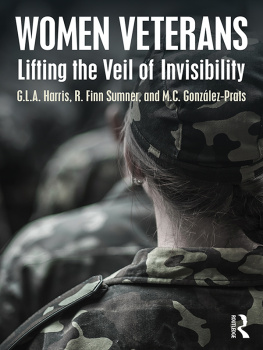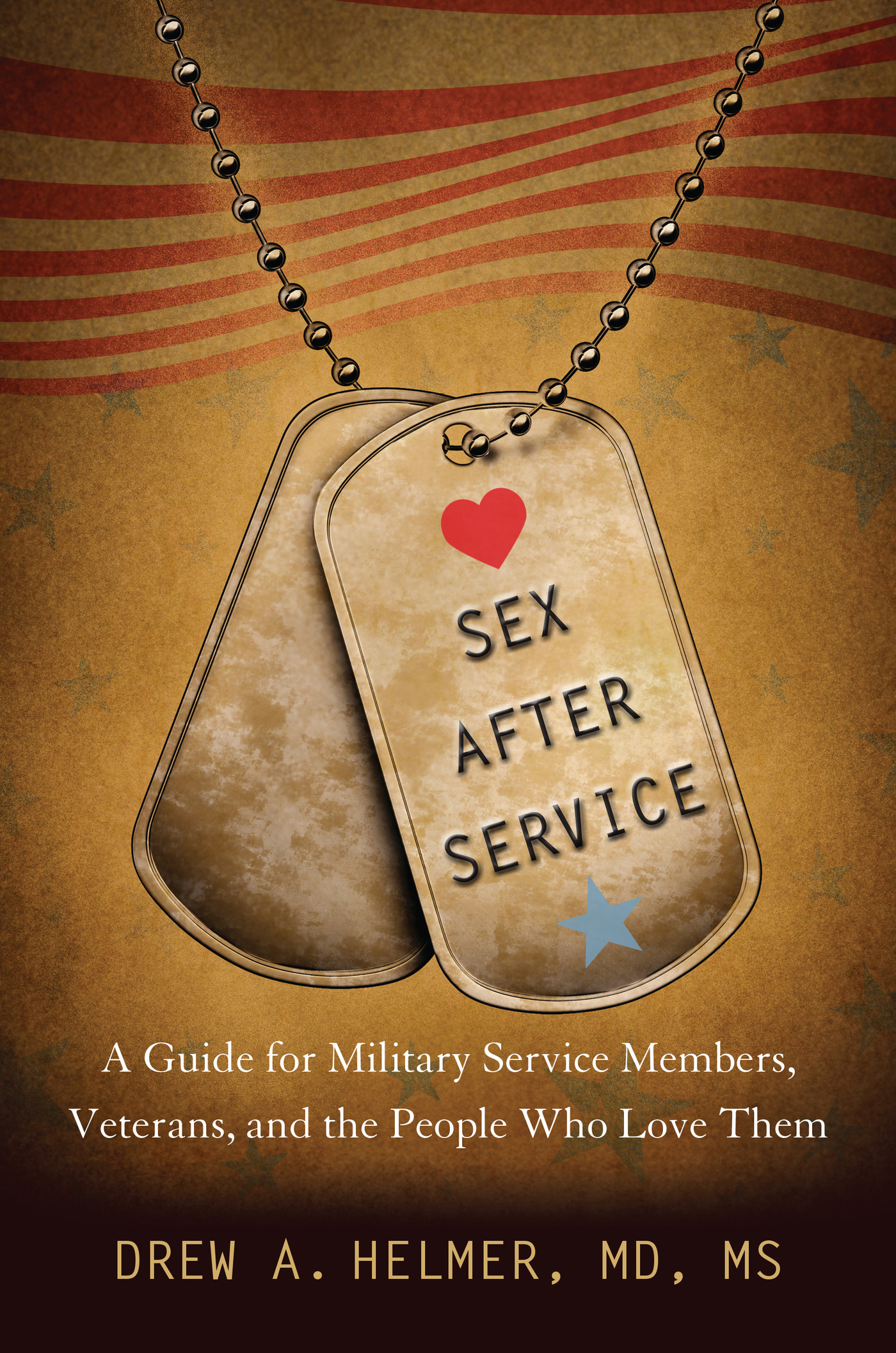Sex after Service
Sex after Service
A Guide for Military Service Members, Veterans, and the People
Who Love Them
Drew A. Helmer, MD, MS
ROWMAN & LITTLEFIELD
Lanham Boulder New York London
Published by Rowman & Littlefield
A wholly owned subsidiary of The Rowman & Littlefield Publishing Group, Inc.
4501 Forbes Boulevard, Suite 200, Lanham, Maryland 20706
www.rowman.com
Unit A, Whitacre Mews, 2634 Stannary Street, London SE11 4AB, United Kingdom
Copyright 2015 by Rowman & Littlefield
All rights reserved. No part of this book may be reproduced in any form or by any electronic or mechanical means, including information storage and retrieval systems, without written permission from the publisher, except by a reviewer who may quote passages in a review.
British Library Cataloguing in Publication Information Available
Library of Congress Cataloging-in-Publication Data
Helmer, Drew A., 1970
Sex after service : a guide for military service members, veterans, and the people who love them / Drew A. Helmer.
pages cm
Includes bibliographical references and index.
ISBN 978-1-4422-3056-9 (cloth : alk. paper)ISBN 978-1-4422-3057-6 (electronic)
1. Sexual health. 2. Sexual disorders. 3. SoldiersHealth and hygiene. 4. SoldiersSexual behavior. 5. VeteransHealth and hygiene. 6. VeteransSexual behavior. I. Title.
RA788.H45 2014
613.9'508697dc23
2014023952
 TM The paper used in this publication meets the minimum requirements of American National Standard for Information Sciences Permanence of Paper for Printed Library Materials, ANSI/NISO Z39.48-1992.
TM The paper used in this publication meets the minimum requirements of American National Standard for Information Sciences Permanence of Paper for Printed Library Materials, ANSI/NISO Z39.48-1992.
Printed in the United States of America
This book is dedicated to the many veterans Ive served through my medical practice. They say practice makes perfect, and working with dedicated men and women like you who sacrificed for me and my family motivates me to practice even harder. Thank you.
Introduction
Welcome, military service members, veterans, and the people who love them! This book serves as an authoritative resource on all manner of sexual health issues. Written for a general audience, the content of this book is based on well-accepted scientific theories and draws on clinical experience, expert opinion, and scientific evidence to share important information about sexual health.
Sexual health issues are common and diverse; more than one-third of Americans report difficulties with sexual function, and this proportion increases with age. Common concerns include interpersonal relationships, difficulty engaging in sexual activity, physical abnormalities of the genitals and reproductive organs, and dissatisfaction with sexual activity. Numerous and various factors contribute to sexual dysfunction, including general health status, specific diseases and conditions, medications to treat some conditions, psychosocial dysfunction, physical and psychological trauma, and more. Sexual dysfunction has a negative impact on the overall health of the individual suffering with it and can also impact his or her partners and relationships. People want sexual health and want their relationship to reflect a healthy state.
Yet sexual health is a taboo topic. It is too often dismissed as unimportant and stigmatized in mainstream health care settings. In fact, sexual dysfunction is often not recognized, discussed, or appropriately evaluated. Patients report that they would like to speak to their health care providers about sexual health concerns but dont feel comfortable initiating the discussion, dont know how to adequately describe their symptoms, or feel they may be ignored or laughed at. Sexual health remains one of the more challenging topics for medical trainees, and even experienced health care providers often do not ask patients about their sexual health or function.
Military service members and veterans are perhaps particularly vulnerable to sexual dysfunction given some common experiences in the military and during combat deployments. Combat deployment is an inherently stressful experience, made worse with actual combat exposure and other physical and psychological hardships and trauma. This in turn contributes to higher rates of physical damage (including traumatic brain injury, amputations, and large-joint injuries), posttraumatic stress disorder (PTSD), and unhealthy coping mechanisms (alcohol and substance abuse). Medications commonly prescribed to treat or manage these conditions, such as opioids for pain and medications for PTSD, anxiety, and depression, can also contribute to sexual dysfunction. Perhaps worst of all, the most intense period of experiencing these complications of deployment is likely to occur when the service member or veteran is 20 to 35 years old, the life stage at which most Americans are dating, selecting a partner, and creating a family. Sexual dysfunction can have significant impacts on all of those important activities.
This book examines the effects of military and combat experience on sexual health and function in a comprehensive yet approachable way. It is based on a review of the science and informed by the authors experiences as a primary care provider and sexual health researcher. After treating hundreds of veterans as a primary care physician and as an expert in postdeployment health concerns, the author has helped veterans with a very wide range of sexual health concerns and variety of sexual dysfunction. He has seen firsthand how these issues affect the broader health and quality of life of the patient and his or her family. He shares these experiences by enlivening the text with illustrative examples that highlight the relevant points while protecting the identity of the actual patients.
After building reader knowledge and confidence in matters related to sexual health in the first chapters, the book describes what can go wrong for military service members and veterans. It then clarifies the boundaries of what is normal and what might be a sign of a problem requiring expert attention. Finally, it identifies appropriate sources of help and suggests a rubric for discussing sexual health concerns with professionals.
Starting with an introduction to the basic concepts of sexual health (chapter 1), the book establishes a shared knowledge base of pertinent biology, anatomy, and physiology with clear writing and organizational structure. By including a discussion of military culture, structure, and processes relevant to the sexual health of military personnel and veterans (chapter 2), the author lays the groundwork for the key lessons in chapters 3 to 5, the effects of combat on overall health, sexual health and function, and differences in these effects between men and women. These three chapters form the core of the book and delve into the factors contributing to sexual health and dysfunction.
Chapter 6 returns to a more general perspective, describing the effects of aging and life stage on sexual health and function. This content follows the discussion of effects of combat because most military service members join the military before the age of 20 and have a relatively limited history of sexual activity prior to military service. This chapter explores the overlap and interactions between normal aging and sexual health issues brought on by military (and combat) experience. Finally, chapters 7 and 8 clearly articulate a process for determining if there is a sexual health issue that rises to the level of a problem and what can be done about it. This is handled with a positive, hopeful tone and general yet effective suggestions on where and how to seek assistance.
Next page








 TM The paper used in this publication meets the minimum requirements of American National Standard for Information Sciences Permanence of Paper for Printed Library Materials, ANSI/NISO Z39.48-1992.
TM The paper used in this publication meets the minimum requirements of American National Standard for Information Sciences Permanence of Paper for Printed Library Materials, ANSI/NISO Z39.48-1992.